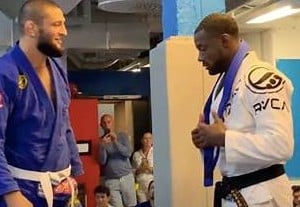GSP and John Danaher: World-Class Combat Training
Few relationships in combat sports are as respected—or as effective—as between Georges St-Pierre (GSP) and John Danaher. One is widely regarded as the greatest MMA fighter of all time, and the other is one of the most sought-after and cerebral coaches in martial arts history. Together, they formed a training partnership that merged athleticism, discipline, and elite-level strategy, creating a model modern fighters continue to study and emulate.
A Meeting of Mind and Muscle
When GSP began seeking new ways to sharpen his ground game in the mid-2000s, he turned to Renzo Gracie Academy in New York, where John Danaher had already built a reputation as a brilliant, if unconventional, grappling coach. While GSP was known for his explosive athleticism and striking acumen, he understood that mastering positional grappling and submission defense would be key to maintaining his dominance in the UFC.
Danaher, known for his meticulous approach to jiu-jitsu and strategic frameworks, quickly became a central figure in GSP’s training camps for jiu-jitsu and overall fight strategy. He helped GSP build a defensive, control-oriented ground game that neutralized submissions and systematically wore opponents down.
Precision Over Flash
Their shared philosophy made the GSP-Danaher partnership so powerful: win with precision, not flash.
Danaher’s teaching emphasized:
- Positional hierarchy and control
- Submission threat without overcommitting
- Energy conservation and decision-making
- Understanding opponent psychology
GSP took this to heart, using grappling not just to hunt submissions, but to dominate positionally, drain energy, and make opponents feel trapped. This led to high-profile victories over ground specialists like B.J. Penn, Jon Fitch, and Jake Shields, where GSP’s ability to control without reckless engagement became his signature.
The Evolution of Strategy
John Danaher didn’t just teach GSP techniques; he taught him how to build systems. These systems mirrored what Danaher would later formalize in his now-famous instructionals (e.g., the leg lock system, back attack system, etc.). For GSP, this meant understanding how one position led to another, using his wrestling to enter dominant spots, and cycling between pressure and movement.
Danaher also played a pivotal role in GSP’s comeback fight against Michael Bisping in 2017. After a four-year layoff, GSP returned to the Octagon and finished Bisping with a rear-naked choke in the third round—his first finish in nearly a decade. That submission, built on pressure and patience, was a classic Danaher-style sequence.
What Grapplers and Fighters Can Learn
The relationship between GSP and Danaher offers a blueprint for how athletes and coaches can maximize potential through structure, analysis, and discipline. Some key lessons include:
- Mastery over variety: GSP didn’t need 1,000 techniques—he needed to master a few, deeply.
- Train with intention: With Danaher, every rep had purpose. Everything is tied into a system.
- Defense is offense: Much of GSP’s dominance came from his ability to shut down opponents’ games before launching his own.
Related Reading
- Gordon Ryan Instructionals: Beginner to Advanced
- Teaching Yourself to Learn BJJ
- The Problem-Solver’s Mindset in BJJ




